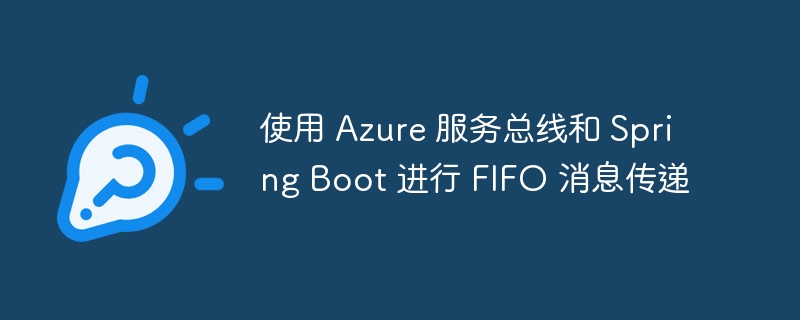使用 Azure 服务总线和 Spring Boot 进行 FIFO 消息传递

介绍
azure 服务总线是一个完全托管的消息代理,可促进分布式应用程序之间的可靠通信。对于需要按特定顺序处理消息的应用程序,例如确保先进先出 (fifo) 顺序,azure 服务总线中的会话提供了一种有效的消息处理机制。
在 spring boot 应用程序的上下文中,利用 azure 服务总线主题上的会话可确保单个使用者一次以正确的顺序处理具有相同会话 id 的消息。在处理高吞吐量消息传递场景并同时保持消息顺序时,此解决方案特别有用。
本指南概述了如何配置 spring boot 应用程序以按照 fifo 顺序使用来自 azure 服务总线的消息,通过使用会话来确保可靠性和可扩展性,而无需复杂的基础设施。
在实践中
对于部署在多个实例上的 spring boot 应用程序,以按 fifo 顺序使用来自 azure 服务总线主题的消息,您可以在该主题上使用会话,并将应用程序配置为在权限之间协调管理会话。操作方法如下:
1. 在 azure 服务总线主题上启用会话
- 确保 azure 服务总线 主题 和 订阅 配置为使用 会话。
- 发送消息时,为每条消息设置一个session id,以确保具有相同session id的所有消息一次只会被一个消费者按到达顺序处理.
2.使用azure sdk在spring boot中管理会话
azure 提供了 java 库,允许以有序的方式通过会话使用消息。这是一种方法:
添加 azure 服务总线依赖项
在 spring boot 项目中添加 azure 服务总线的依赖项(在 maven 的 pom.xml 中):
<dependency>
<groupid>com.azure</groupid>
<artifactid>azure-messaging-servicebus</artifactid>
<version>7.5.0</version> <!-- check for the last version -->
</dependency>
在应用程序中配置服务总线
配置应用程序以连接到 azure 服务总线主题。这是基本配置:
import com.azure.messaging.servicebus.*; @service public class azureservicebusconsumer { private final string connectionstring = "endpoint=sb://<your-service-bus>.servicebus.windows.net/;sharedaccesskeyname=<key-name>;sharedaccesskey=<key>"; private final string topicname = "<your-topic>"; private final string subscriptionname = "<your-subscription>"; public void startsessionprocessor() { servicebusclientbuilder clientbuilder = new servicebusclientbuilder() .connectionstring(connectionstring); servicebusprocessorclient processorclient = clientbuilder .sessionprocessor() // using session mode .topicname(topicname) .subscriptionname(subscriptionname) .processmessage(this::processmessage) .processerror(this::processerror) .buildprocessorclient(); // start session processing in asynchronous mode processorclient.start(); } private void processmessage(servicebusreceivedmessagecontext context) { servicebusreceivedmessage message = context.getmessage(); system.out.printf("processing message from session: %s. contents: %s%n", message.getsessionid(), message.getbody()); // process the message here, respecting the order of arrival in the session context.complete(); // mark the message as processed } private void processerror(servicebuserrorcontext context) { system.err.printf("error occurred while processing: %s%n", context.getexception().getmessage()); } }
确保每个会话的独特消费
使用 sessionprocessor() 可确保每个会话一次仅由一个实例消耗,并且无论实例数量如何,会话中的消息始终按 fifo 顺序处理。
3. ec2实例之间的并发管理
当应用程序的多个 ec2 实例连接到主题时:
- azure 服务总线动态地将会话分配给可用的使用者。
- 每个 spring boot 实例一次接收一个会话的消息,azure 服务总线确保活动会话不会同时分配给多个使用者。
- 这允许自动扩展,每个实例并行支持不同的会话。
4. 部署和弹性
在具有相同服务总线配置的 ec2 实例上部署 spring boot 应用程序,以便它们可以动态管理会话。如果实例出现故障,azure 服务总线会自动将等待会话重新分配给另一个连接的 ec2 实例。
5. spring boot 中启动示例
在 spring boot 应用程序启动时启动消费者,使用 @postconstruct 启动会话内消费:
import javax.annotation.PostConstruct; import org.springframework.stereotype.Service; @Service public class AzureServiceBusConsumer { // ... (configuration and previous code) @PostConstruct public void init() { startSessionProcessor(); } }
结论
总而言之,利用会话可以有效地实现将 azure 服务总线与 spring boot 应用程序集成以进行 fifo 消息处理。通过在 azure 服务总线主题上启用会话并将消息与特定会话 id 相关联,您可以确保在每个会话中消息按照其到达的确切顺序进行处理。
使用 azure sdk for java,可以将 spring boot 应用程序配置为以基于会话的方式使用消息,从而保证每个会话一次由一个使用者处理。即使在多线程环境中,这也消除了消息重新排序的风险,确保可靠且有序的处理。
这种方法提供了可扩展且有弹性的解决方案,确保应用程序按照严格的 fifo 顺序处理消息,同时保持管理分布式工作负载的效率和灵活性。
以上就是使用 Azure 服务总线和 Spring Boot 进行 FIFO 消息传递的详细内容,更多请关注硕下网其它相关文章!
